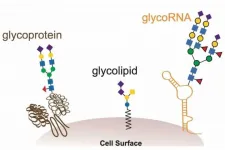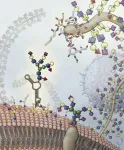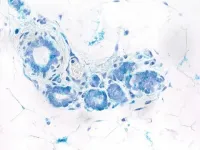(Press-News.org) The development of dementia, often from Alzheimer's disease, late in life is associated with abnormal blood levels of dozens of proteins up to five years earlier, according to a new study led by researchers at the Johns Hopkins Bloomberg School of Public Health. Most of these proteins were not known to be linked to dementia before, suggesting new targets for prevention therapies.
The findings are based on new analyses of blood samples of over ten thousand middle-aged and elderly people--samples that were taken and stored during large-scale studies decades ago as part of an ongoing study. The researchers linked abnormal blood levels of 38 proteins to higher risks of developing Alzheimers within five years. Of those 38 proteins, 16 appeared to predict Alzheimer's risk two decades in advance.
Although most of these risk markers may be only incidental byproducts of the slow disease process that leads to Alzheimer's, the analysis pointed to high levels of one protein, SVEP1, as a likely causal contributor to that disease process.
The study was published May 14 in Nature Aging.
"This is the most comprehensive analysis of its kind to date, and it sheds light on multiple biological pathways that are connected to Alzheimer's," says study senior author Josef Coresh, MD, PhD, MHS, George W. Comstock Professor in the Department of Epidemiology at the Bloomberg School. "Some of these proteins we uncovered are just indicators that disease might occur, but a subset may be causally relevant, which is exciting because it raises the possibility of targeting these proteins with future treatments."
More than six million Americans are estimated to have Alzheimer's, the most common type of dementia, an irreversible fatal condition that leads to loss of cognitive and physical function. Despite decades of intensive study, there are no treatments that can slow the disease process, let alone stop or reverse it. Scientists widely assume that the best time to treat Alzheimer's is before dementia symptoms develop.
Efforts to gauge people's Alzheimer's risk before dementia arises have focused mainly on the two most obvious features of Alzheimer's brain pathology: clumps of amyloid beta protein known as plaques, and tangles of tau protein. Scientists have shown that brain imaging of plaques, and blood or cerebrospinal fluid levels of amyloid beta or tau, have some value in predicting Alzheimer's years in advance.
But humans have tens of thousands of other distinct proteins in their cells and blood, and techniques for measuring many of these from a single, small blood sample have advanced in recent years. Would a more comprehensive analysis using such techniques reveal other harbingers of Alzheimer's? That's the question Coresh and colleagues sought to answer in this new study.
The researchers' initial analysis covered blood samples taken during 2011-13 from more than 4,800 late-middle-aged participants in the Atherosclerosis Risk in Communities (ARIC) study, a large epidemiological study of heart disease-related risk factors and outcomes that has been running in four U.S. communities since 1985. Collaborating researchers at a laboratory technology company called SomaLogic used a technology they recently developed, SomaScan, to record levels of nearly 5,000 distinct proteins in the banked ARIC samples.
The researchers analyzed the results and found 38 proteins whose abnormal levels were significantly associated with a higher risk of developing Alzheimer's in the five years following the blood draw.
They then used SomaScan to measure protein levels from more than 11,000 blood samples taken from much younger ARIC participants in 1993-95. They found that abnormal levels of 16 of the 38 previously identified proteins were associated with the development of Alzheimer's in the nearly two decades between that blood draw and a follow-up clinical evaluation in 2011-13.
To verify these findings in a different patient population, the scientists reviewed the results of an earlier SomaScan of blood samples taken in 2002-06 during an Icelandic study. That study had assayed proteins including 13 of the 16 proteins identified in the ARIC analyses. Of those 13 proteins, six were again associated with Alzheimer's risk over a roughly 10-year follow-up period.
In a further statistical analysis, the researchers compared the identified proteins with data from past studies of genetic links to Alzheimer's. The comparison suggested strongly that one of the identified proteins, SVEP1, is not just an incidental marker of Alzheimer's risk but is involved in triggering or driving the disease.
SVEP1 is a protein whose normal functions remain somewhat mysterious, although in a study published earlier this year it was linked to the thickened artery condition, atherosclerosis, which underlies heart attacks and strokes.
Other proteins associated with Alzheimer's risk in the new study included several key immune proteins--which is consistent with decades of findings linking Alzheimer's to abnormally intense immune activity in the brain.
The researchers plan to continue using techniques like SomaScan to analyze proteins in banked blood samples from long-term studies to identify potential Alzheimer's-triggering pathways--a potential strategy to suggest new approaches for Alzheimer's treatments.
The scientists have also been studying how protein levels in the ARIC samples are linked to other diseases such as vascular (blood vessel-related) disease in the brain, heart and the kidney.
INFORMATION:
First author Keenan Walker, PhD, worked on this analysis while on faculty at the Johns Hopkins University School of Medicine and the Bloomberg School's Welch Center for Prevention, Epidemiology and Clinical Research. He is currently an investigator with the National Institute of Aging's Intramural Research Program.
"Large-scale plasma proteomic analysis identifies proteins and pathways associated with dementia risk" was co-authored by Keenan Walker, Jingsha Chen, Jingning Zhang, Myriam Fornage, Yunju Yang, Linda Zhou, Morgan E. Grams, Adrienne Tin, Natalie Daya, Ron Hoogeveen, Aozhou Wu, Kevin Sullivan, Peter Ganz, Scott Zeger, Elias Gudmundsson, Valur Emilsson, Lenore Launer, Lori Jennings, Vilmundur Gudnason, Nilanjan Chatterjee, Rebecca Gottesman, Thomas Mosley, Eric Boerwinkle, Christie Ballantyne, and Josef Coresh.
The study was supported by grants from the National Institutes of Health (K23 AG064122, K24 AG052573, U01-AG052409, R01-HL134320). END
May 16, 2021 -- In a study of low-income, urban youth in the U.S., researchers at Columbia University Mailman School of Public Health found that students exposed to Photovoice, an educational intervention, experienced greater improvements in STEM-capacity scores and environmental awareness scores compared to a group of youth who were not exposed to the activity. The results suggest that the Photovoice activities may be associated with improved learning outcomes. The study is published in the International Journal of Qualitative Methods.
"Our findings suggest that the Photovoice activities result in greater environmental awareness and may be associated with improved learning skills," said Nadav Sprague, doctoral fellow, ...
Stanford researchers have discovered a new kind of biomolecule that could play a significant role in the biology of all living things.
The novel biomolecule, dubbed glycoRNA, is a small ribbon of ribonucleic acid (RNA) with sugar molecules, called glycans, dangling from it. Up until now, the only kinds of similarly sugar-decorated biomolecules known to science were fats (lipids) and proteins. These glycolipids and glycoproteins appear ubiquitously in and on animal, plant and microbial cells, contributing to a wide range of processes essential for life.
The newfound glycoRNAs, neither ...
FRANKFURT. There are currently only a few synthetic agents that bind to and block the widespread membrane transport proteins, ATP-binding cassette transporters (ABC). Scientists at Goethe University and the University of Tokyo identified four of these macrocyclic peptides as models for a novel generation of active substances. They used methods for which the scientists involved are considered world leaders.
Thanks to deep sequencing, an extremely fast and efficient read-out procedure, the desired macrocyclic peptides could be filtered out of a "library" ...
In a surprise find, scientists have discovered sugar-coated RNA molecules decorating the surface of cells.
These so-called "glycoRNAs" poke out from mammalian cells' outer membrane, where they can interact with other molecules. This discovery, reported May 17, 2021, in the journal Cell, upends the current understanding of how the cell handles RNAs and glycans.
"This was probably the biggest scientific shock of my life," says study author END ...
PULLMAN, Wash. -- Washington State University researchers have developed an innovative way to convert plastics to ingredients for jet fuel and other valuable products, making it easier and more cost effective to reuse plastics.
The researchers in their reaction were able to convert 90% of plastic to jet fuel and other valuable hydrocarbon products within an hour at moderate temperatures and to easily fine-tune the process to create the products that they want. Led by graduate student Chuhua Jia and Hongfei Lin, associate professor in the Gene and Linda Voiland School of Chemical Engineering and Bioengineering, they report on their work in the journal, ...
What The Study Did: Researchers assessed the feasibility of using positive behavior supports to promote the use of face coverings in school-aged children with autism spectrum disorders and/or attention-deficit/hyperactivity disorder (ADHD) attending a summer program during the COVID-19 pandemic.
Authors: Benjamin Aaronson, Ph.D., of the University of Washington in Seattle, is the corresponding author.
To access the embargoed study: Visit our For The Media website at this link https://media.jamanetwork.com/
(doi:10.1001/jamanetworkopen.2021.10281)
Editor's Note: The article includes conflicts of interest disclosures. Please see the article for additional information, including other authors, author ...
What The Study Did: Hospital discharge rates, hospitalization outcomes and demographic factors were examined among U.S. patients with ischemic stroke before and during the COVID-19 pandemic.
Authors: Adam de Havenon, M.D., of the University of Utah in Salt Lake City, is the corresponding author.
To access the embargoed study: Visit our For The Media website at this link https://media.jamanetwork.com/
(doi:10.1001/jamanetworkopen.2021.10314)
Editor's Note: The article includes conflict of interest and funding/support disclosures. Please see the article for additional information, including other authors, author contributions and affiliations, conflict of interest ...
What The Study Did: Online search data were used to assess changes in home birth information seeking across the United States and United Kingdom during the COVID-19 pandemic.
Authors: Christina N. Schmidt, B.S., of the University of California, San Francisco, is the corresponding author.
To access the embargoed study: Visit our For The Media website at this link https://media.jamanetwork.com/
(doi:10.1001/jamanetworkopen.2021.10310)
Editor's Note: Please see the article for additional information, including other authors, author contributions and affiliations, conflict of interest and financial disclosures, and funding and support.
INFORMATION:
Media advisory: The full study is linked to this news release.
Embed this link to provide your readers free access ...
Early diagnosis and improvement of breast cancer treatments have reduced breast cancer mortality in recent years, with survival rates reaching 85% today. In spite of these data, breast cancer was still the most frequently diagnosed tumour in the world in 2020, mainly due to increased population screening and social factors such as ageing. RANK protein plays a key role in the development of these tumours. Located in the membrane of cells, when it binds to its partner RANKL, it sends signals that stimulate the development of the mammary gland. When these proteins do not work properly, breast cells begin to divide and multiply ...
Mitochondria - the 'batteries' that power our cells - play an unexpected role in common diseases such as type 2 diabetes and multiple sclerosis, concludes a study of over 350,000 people conducted by the University of Cambridge.
The study, published today in Nature Genetics, found that genetic variants in the DNA of mitochondria could increase the risk of developing these conditions, as well influencing characteristics such as height and lifespan.
There was also evidence that some changes in mitochondrial DNA were more common in people with Scottish, Welsh or Northumbrian genetic ancestry, implying that mitochondrial DNA and nuclear DNA (which accounts for 99.9% of our genetic make-up) interact with each other.
Almost ...


